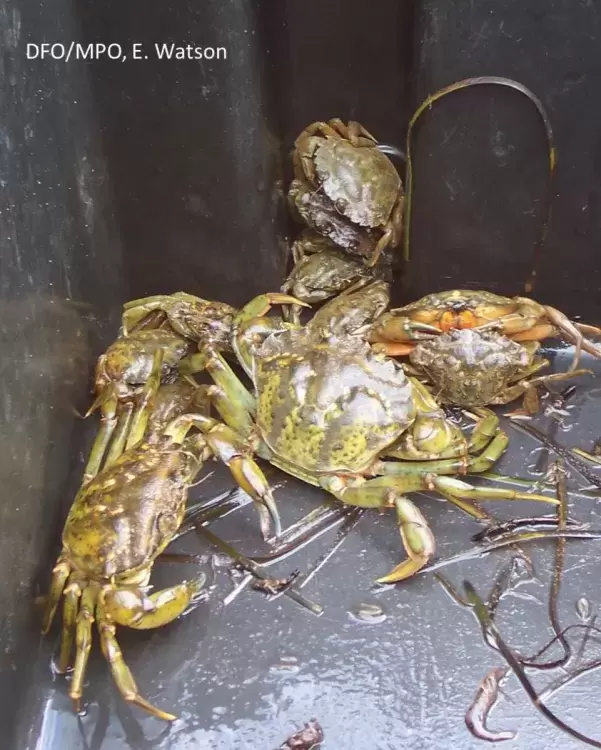The Lummi Nation has declared a disaster after removing 70,000 invasive European green crabs from their sea pond in November.
According to Seattle-based King News, the Lummi Nation cultivates shellfish and juvenile salmon in their 750-acre sea pond. The European green crab preys on young oysters, clams, and are known to dig down into the sand, uprooting eel grass, which is habitat for juvenile salmon.
Fisheries and Oceans Canada (DFO) states that the European green crab may pose a serious threat to estuarine and marine ecosystems, as they are voracious predators feeding on a variety of intertidal animals, including oysters, mussels, clams, and juvenile Dungeness crab.
“This species changes the balance between species in the ecosystems and impacts their diversity,” said DFO in a Jan 29, 2021 statement.
Ahousaht Fisheries Manager Luke Swan Jr. confirms that the invasive species has been found on Ahousaht beaches.
“A lot of the clam diggers kill what they find. When we go on beaches to patrol, we take what we find in a bucket to kill them as they are invasive,” he told Ha-Shilth-Sa.
Swan went to say that he believes his nation is working with a biologist to come up with a plan.
Uu-a-thluk Deputy Manager Jim Lane confirms that the European green crab is established on the west coast of Vancouver Island. But control programs require long-term commitment and resources. He says some nations have supported a couple of proposals to external funders to support monitoring and control programs, but have yet to receive funding.
“The WCVI area is too vast to implement control programs for all areas, so nations and others will need to identify priority areas for control as a first step,” Lane told Ha-Shilth-Sa.
According to a DFO information map, there have been confirmed European green crab sightings in Barkley Sound, Clayoquot Sound and Nootka Sound as of August 2021.
The European green crab (Carcinus maenas) is native to several European coastal areas. It’s believed that the creature first arrived in North America around 1817, likely as adults carried in the holds of wooden ships. The first green crabs in Canadian waters were seen in 1951 in southwestern New Brunswick, and have since spread to other parts of Atlantic Canada, according to DFO.
The European green crab has already invaded numerous coastal communities outside its native range, including South Africa, Brazil, Australia, and both coasts of North America. An able colonizer and efficient predator, this small shore crab has the potential to significantly alter any ecosystem it invades, according to the Washington Sea Grant website.
According to DFO, the European Green Crab gained a foothold on the western shores of North America in 1989 at San Francisco, California. It has steadily advanced north, reaching British Columbia in 1998 or 1999. It continues to spread north, threatening shellfish, native crab, and eelgrass beds.
The Nature Conservancy states they were found along southern Vancouver Island in 1999, and its range continues to expand along the coast.
DFO has been conducting surveys and monitoring the invasion of the European green crab since 2006. They say that larval supply is continually coming in from the south as freely floating pelagic larvae. Control efforts, they say, must consider this.
The Washington Sea Grant says that the ballast water of ships is believed to be the mode of transportation for the spreading of many invasive species.
“To prevent the invasion of the European green crab into Kachemak Bay, the ballast water of all incoming ships might be deoxygenized to kill the green crab larvae in it,” wrote the organization referencing a coastal part of Alaska.
The Lummi Indian Business Council say they hope to raise awareness and draw on resources to combat the European green crab, before it overtakes their territory.
The European green crab is not always green. It can be reddish orange to a dark, mottled green. Its distinguishing feature is the five spines on both edges of the shell that run from the eyes to the large claws.
DFO advises that if you think you found a European green crab, send a photo, date of observation and location to AISPACIFIC@DFO-MPO.GC.CA
Boaters are advised to clean plants, animals and mud from their boats and equipment, drain all water from vessels onto land and completely dry all parts of the boat and gear.

